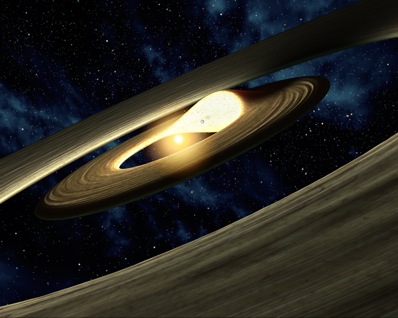
Spitzer spots swirling clump of planetary stuff
DR EMILY BALDWIN
ASTRONOMY NOW
Posted: September 24, 2009


According to new observations made by NASA's Spitzer Space Telescope, a star or planet appears to be pushing a clump of planet-forming material around a young star.
Spitzer astronomers were studying a young star known as LRLL 31 in infrared light and were surprised to see that the star's light varied in unexpected ways and on rapid timescales of as little as one week. Since planets form out of swirling discs of gas and dust over timescales of millions of years, it is rare to see such intense changes.
The team speculate that a close companion to the star, either another star or a developing planet, could be manipulating the material, causing its thickness to vary as it spins around the star. “We don’t know if planets have formed, or will form, but we are gaining a better understanding of the properties and dynamics of the fine dust that could either become, or indirectly shape, a planet,” says James Muzerolle of the Space Telescope Science Institute. “This is a unique, real-time glimpse into the lengthy process of building planets.”
 This artist's conception shows a lump of material in a swirling, planet-forming disc that is likely being pushed around the star by a companion, either another star or a young planet. Image: NASA/JPL-Caltech.
This artist's conception shows a lump of material in a swirling, planet-forming disc that is likely being pushed around the star by a companion, either another star or a young planet. Image: NASA/JPL-Caltech.
One theory of planet formation holds that they begin life as small dusty grains and over time bulk up due to collisions. Eventually these proto-planets are large enough to carve out gaps in the swirling dust disc. This is known as a transitional disc and over time is replaced by a disc made up of debris resulting from more dramatic collisions between asteroids, comets and planets.
The warm glow of the transitional discs can be detected by Spitzer and used to map out their morphology. Muzerolle and colleagues focused on young stars around two to three million years old with known transitional discs. LRLL 31 was one of the candidates selected within the star-forming region of the constellation Perseus, and was studied for five months.
The observations revealed that light from the inner region of the star’s disc changes every few weeks, and, in one instance, in only one week, with both the intensity and the wavelength of infrared radiation varying with time. “Transition discs are rare enough, so to see one with this type of variability is really exciting,” says co-author Kevin Flaherty of the University of Arizona.
The scientists suggest that a companion to the star, located in the gap of the disc, would periodically change the height of the inner disc rim as it circles around its host to produce the observed phenomena. “A higher rim would emit more light at shorter wavelengths because it is larger and hot, but at the same time, the high rim would shadow the cool material of the outer disc, causing a decrease in the longer-wavelength light. A low rim would do the opposite,” says co-author Elise Furlan of NASA’s Jet Propulsion Laboratory. “This is exactly what we observe in our data.” But the companion would have to be as close to the star as one-tenth the distance between Earth and the Sun in order to move the material around so fast.
The next step will be to employ ground-based telescopes to see if the suspected companion is tugging on the star hard enough to be detected. Spitzer will also return to the subject again as part of its warm mission. “For astronomers, watching anything in real-time is exciting,” says Muzerolle. “It’s like we’re biologists getting to watch cells grow in a petri-dish, only our specimen is light-years away.”
Muzerolle and his colleagues' work is presented in a forthcoming issue of the Astrophysical Journal Letters.
|



